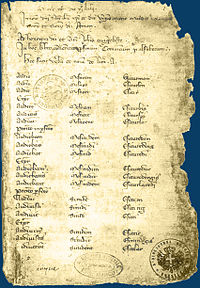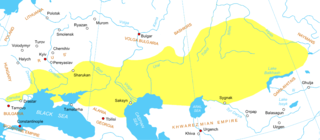This article has multiple issues. Please help improve it or discuss these issues on the talk page. (Learn how and when to remove these messages)
|
Cuman or Kuman (also called Kipchak, Qypchaq or Polovtsian, self referred to as Tatar (tatar til) in Codex Cumanicus)[3] was a West Kipchak Turkic language spoken by the Cumans (Polovtsy, Folban, Vallany, Kun) and Kipchaks; the language was similar to today's various languages of the West Kipchak branch. Cuman is documented in medieval works, including the Codex Cumanicus, and in early modern manuscripts, like the notebook of Benedictine monk Johannes ex Grafing.[4] It was a literary language in Central and Eastern Europe that left a rich literary inheritance. The language became the main language (lingua franca) of the Golden Horde.[5]
| Cuman | |
|---|---|
| Kipchak | |
| Tatar til | |
 Codex Cumanicus | |
| Native to | Cuman–Kipchak Confederation, Golden Horde |
| Region | Cumania |
| Ethnicity | Cumans, Kipchaks, Tatars |
| Extinct | In Kunság: 1770, with the death of István Varró[1] Other regions: evolved into other Kipchak languages |
| Arabic, Latin | |
| Language codes | |
| ISO 639-3 | qwm |
qwm | |
| Glottolog | cuma1241 |
 Map of territory occupied by the Cumans around 1200 | |
History
editThe Cumans were nomadic people who lived on the steppes of Eastern Europe, north of the Black Sea, before the Golden Horde. Many Turkic peoples including the Crimean Tatars, Karachays, Kumyks, Crimean Karaites, Krymchaks and Balkars, Manavs are descended from the Cumans. Today, the speakers of these various languages belonging to the Kipchak branch speak variations closely related to the Cuman language.[6][7][8][9]
The literary Cuman language became extinct in the early 18th century in the region of Cumania in Hungary, which was its last stronghold. Tradition holds that the last speaker of the Cuman language in Hungary was István Varró, a resident of Karcag (Hungary) who died in 1770. The Cuman language in Crimea, however, managed to survive. The Cuman language is considered the direct ancestor of the current language of the Crimean Tatars with possible incorporations of the other languages in the region, like Crimean Gothic.[10][11][12]
By a preponderance Cumanian population of the Crimea acquired the name "Tatars", embraced Islam, and retained the Quman-Qipchaq Turkic language, and the process of consolidating the multi-ethnic conglomerate of the Peninsula began, which has led to the emergence of the Crimean Tatar people.[13]
The Cuman-Kipchaks had an important role in the history of Anatolia, Kazakhstan, Ukraine, Russia, Georgia, Hungary, Romania (see, for example, the Basarab dynasty), Moldavia, Bessarabia and Bulgaria.[14][15][16][17]
Radlov believed that among the current languages Cuman is closest to the Mishar dialect of the Tatar language.[18]
Sample
editFrom the book known as the Codex Cumanicus, a Cuman Kipchak Turkic Pater Noster (transcribed in the Common Turkic Alphabet):
Atamız kim köktesiñ. Alğışlı bolsun seniñ atıñ, kelsin seniñ xanlığıñ, bolsun seniñ tilemekiñ – neçik kim kökte, alay [da] yerde. Kündeki ötmegimizni bizge bugün bergil. Dağı yazuqlarımıznı bizge boşatqıl – neçik biz boşatırbız bizge yaman etkenlerge. Dağı yekniñ sınamaqına bizni quurmağıl. Basa barça yamandan bizni qutxarğıl. Amen![19]
See also
editReferences
edit- ^ Melnyk, Mykola (2022). Byzantium and the Pechenegs.
István Varró, a member of the Jász-Cuman mission to the empress of Austria Maria Theresa and the known last speaker of the Cuman language, died in 1770.
- ^ Glottolog entry for Cuman
- ^ Florin Curta (2007). The Other Europe in the Middle Ages: Avars, Bulgars, Khazars and Cumans. p. 406.
- ^ Knauer, Georg Nicholaus (2010). "The Earliest Vocabulary of Romani Words (c. 1515) in the Collectanea of Johannes ex Grafing, a student of Johannes Reuchlin and Conrad Celtis". Romani Studies. 20 (1): 1–15. doi:10.3828/rs.2010.1. S2CID 170292032.
- ^ "Turkic written memorials". Old.unesco.kz. Retrieved 27 July 2019.
- ^ Yilmaz, Adil (2018). "Bızans'in Anadolu'ya Yerleştırdığı Son Türkler" [The Last Turks Settled in Anatolia by Byzantium]. Eski̇çağ Araştirmalari Dergi̇si̇ [Journal of Ancient Researches] (in Turkish) (3): 29–32.
- ^ "YALAKOVA'DAN YALOVA'YA Prof. Dr. Halil İnalcık Anısına Yalova Tarihi Araştırmaları" (PDF).
- ^ "Anadolu'ya yerleştirilen Kumanlar (Manavlar)".
- ^ Acar, Kenan (January 2022). "GAGAVUZ TÜRKÇESİ İLE KOCAELİ YERLİ (MANAV) AĞIZLARI ARASINDAKİ PARALELLİKLER, 2022, VI. Uluslararası Türklerin Dünyası Sosyal Bilimler Sempozyumu, PARALLELS BETWEEN GAGAVUZ TURKISH AND KOCAELİ NATİVE TURK (MANAV) DİALECTS, Kenan Acar, 2022, VI. International Turkish World Social Sciences Symposium". VI. Uluslararası Türklerin Dünyası Sosyal Bilimler Sempozyumu.
- ^ István Vásáry (2005) Cumans and Tatars, Cambridge University Press.
- ^ Stearns(1979:39–40).
- ^ "Crimean Tatar proper, called the 'central dialect', belonged to the West Kipchak subbranch as a descendant of Kuman." (Lars Johanson, Turkic, Cambridge University Press, 2021, pg. 62)
- ^ Vozgrin, Valery "Historical fate of the Crimean Tatars" Archived 11 July 2006 at the Wayback Machine
- ^ Sun, Kevin (2019-04-07). "Sun Language Theory, Part 2: The Steppes of Tartary (Tatar, Bashkir, Kazakh, Kyrgyz)". Medium. Retrieved 2019-09-17.
- ^ Ayönü, Yusuf (August 2012). "Bati Anadolu'dakı Türk Yayilișina Karși Bızans İmparatorluğu'nun Kuman-Alan Topluluklarini Balkanlardan Anadolu'ya Nakletmesi" [The Transfer of Cumans and Alans from Balkans to Anatolia by Byzantine Empire against the Turkish Expansion in the Western Anatolia]. Belleten (in Turkish). 76 (276). Turkish Historical Society: 403–418. doi:10.37879/belleten.2012.403. S2CID 245309166. Retrieved October 12, 2022. DOI: English version
- ^ Rustam M. Shukurov. "Latent Turkification of Byzantium (ca. 1071–1461)". Dumbarton Oaks.
- ^ Dimitri Korobeinikov (2015). "The Cumans in Paphlagonia". Karadeniz İncelemeleri Dergisi (18): 29–44.
- ^ "Публикация ННР О языке куманов: По поводу издания куманского словаря". books.e-heritage.ru. Retrieved 2023-07-03.
- ^ Kuun; Géza; et al. (1880). "Codex cumanicus, Bibliothecae ad templum divi Marci Venetiarum primum ex integro editit prolegomenis notis et compluribus glossariis instruxit comes Géza Kuun". Budapest: XLIX. Retrieved August 11, 2016 – via Archive.org.
Sources
edit- Güner, Galip (2013), Kıpçak Türkçesi Grameri, Kesit Press, İstanbul.
- Mustafa Argunşah, Galip Güner (2015), Codex Cumanicus, Kesit Yayınları, İstanbul.